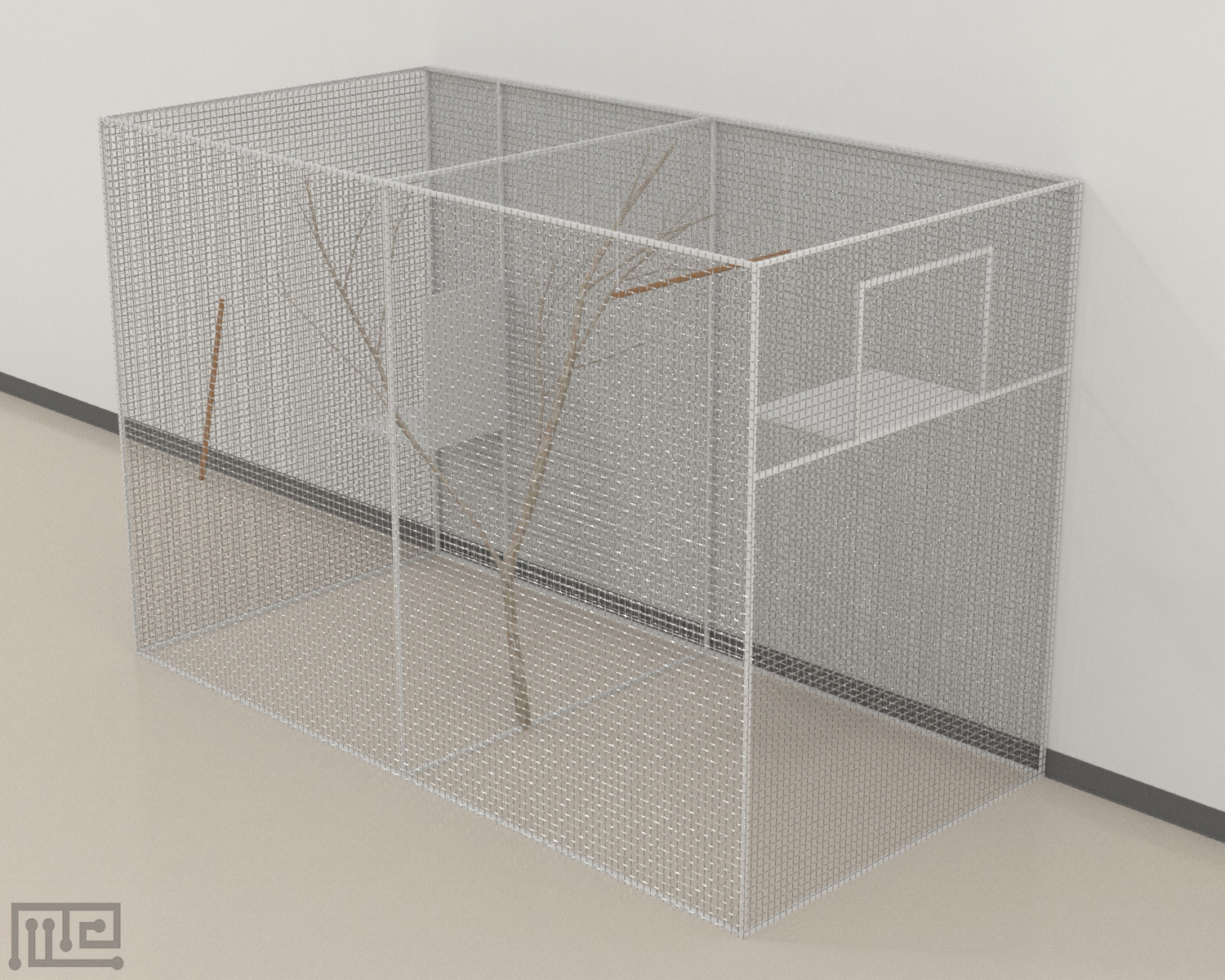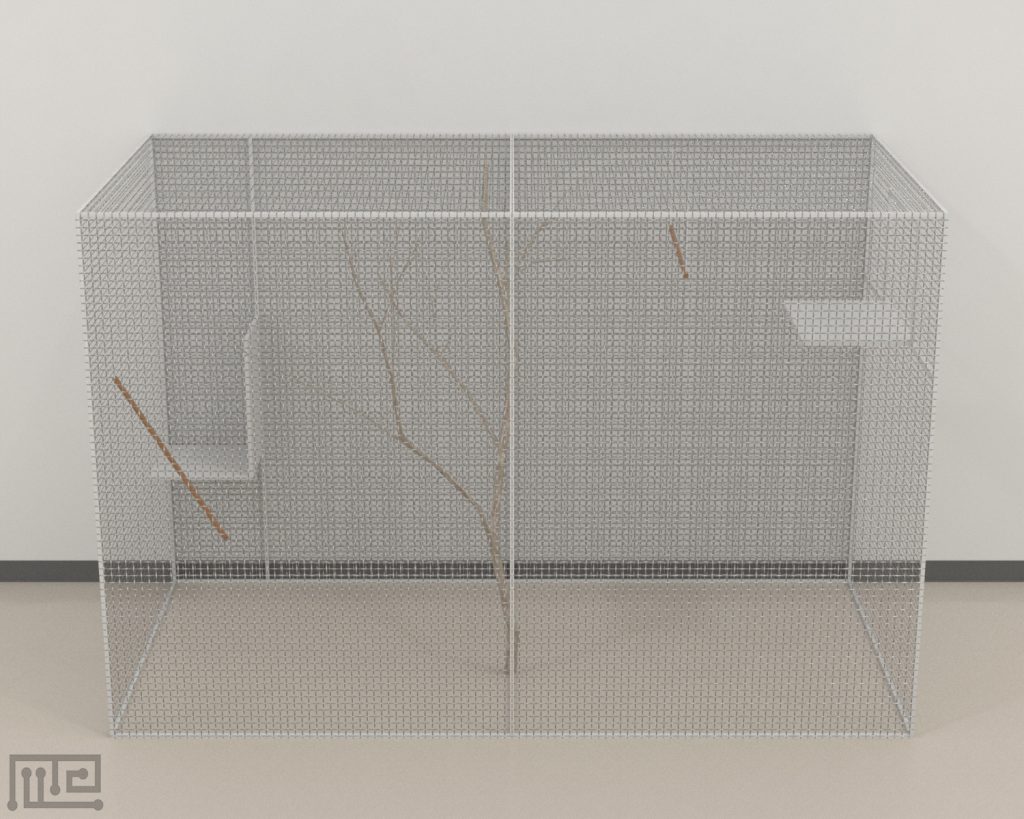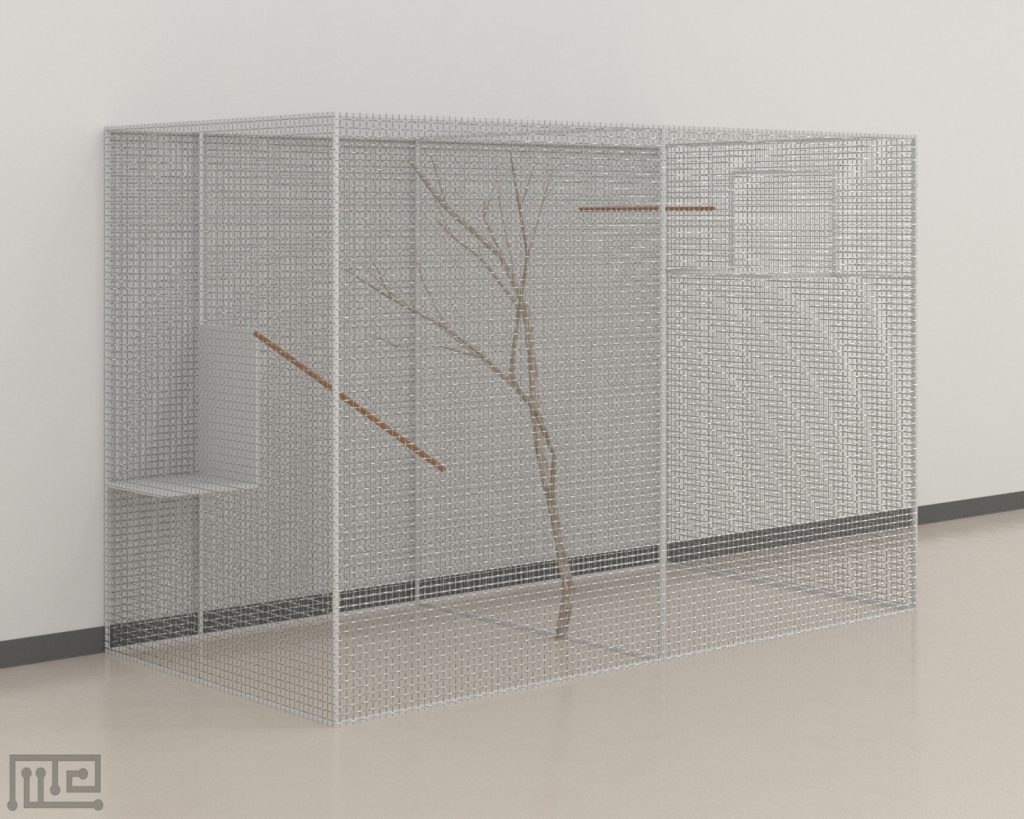The Zebrafinch Testing Cage aviary is divided into two virtual sections of equal size. Section A contained some branches spanning from the floor to the roof of the aviary and located at the border of Section A and B.
The platform was located midway in the shorter side of the cage and high up from the floor of the aviary.
Mazeengineers offers the Zebrafinch Testing Cage.
Price & Dimensions
Zebrafinch Testing Cage
$ 1990
+S&H- Length of aviary: 3m
- Width of aviary: 1.5m
- Height of aviary: 2m
- Length of virtual sections of equal size: 1.5m
- Width of virtual sections of equal size: 1.5m
- Height of virtual sections of equal size: 2m
- Length of main perch: 80cm
- Distance between main perch and where stimulus is presented: 40cm
- Height of main perch above stimulus platform: 30cm
- Length of platform: 40cm
- Width of platform: 60cm
- Height of platform from aviary floor: 140cm
Documentation
Introduction
The Zebra finch Testing Cage is used to study the asymmetry of visual behavior in zebra finches. It consists of an aviary that is virtually divided into two sections and includes perches, branches, and platforms.
The asymmetry of brain function and lateralized behaviors are observed in a wide range of species. Lateralized behaviors, such as limb preferences, are common. However, research is continuously being done to understand how brain lateralization affects cognition, perception, and behavior in different ways (Versace & Vallortigara, 2015). Although asymmetry in visual behavior in avian species was only discovered a few decades ago, newer studies in zebra finches have analyzed how visual asymmetry affects courtship behaviors as well as the recognition of different stimuli (Rogers, Koboroff, and Kaplan, 2018; Templeton, McCracken, Sher, & Mountjoy, 2014). The Zebra finch Testing Cage can be used to observe the eye preference of zebra finches to view different types of stimuli to evaluate visual asymmetry behaviors. The Zebra finch Testing Cage contains a platform in which stimuli of different sizes can be placed, such as threatening stimuli in the form of taxidermic specimens of predators or non-threatening stimuli such as plastic containers.
Other apparatuses used in evaluating zebra finch behaviors include the Zebra finch Day Escape Maze, the Zebra finch Two-Compartment Cage, the Zebra finch Chamber Maze, the Magnetic Compass, and the Mate Choice Apparatus 2.
Apparatus and Equipment
The Zebra finch Testing Cage consists of an aviary that measures 3 m in length, 1.5 m in width, and 2 m in height. It is virtually divided into two equal sections (Section A and Section B) that measure 1.5 cm in length, 1.5 m in width, and 2 m in height. At the border of the two sections, a single branch spans out from the floor and branches into smaller branches in Section B. Section A contains a platform where the stimulus is presented that measures 40 cm in length and 60 cm in width and is located midway in the shorter side of the cage, 140 cm from the floor of the aviary. A small door is present behind the stimulus platform to allow the experimenter to place or remove the stimulus during trials. The main perch of the testing cage is also present in Section A measures 80 cm in length and is located 40 cm from the shorter side of the aviary where the stimulus is presented and is 30 cm above the stimulus platform. In Section B, a perch is present in one corner that allows the subject to see into Section A, while a platform with a visual barrier is present on the other corner, to serve as a refuge.
Training Protocol
Clean the apparatus thoroughly in between trials to avoid odor cues from previous trials. Appropriately light the apparatus. A tracking and recording system such as the Noldus Ethovision XT can be used to assist with observations.
Habituation and Pre-training
Release a pair of subjects into the Zebra finch Testing Cage. Allow the subjects to habituate to the environment for 5 days.
Zebra finch Testing Cage Task
After habituation, allow the subjects to explore the cage for 5 minutes for a pre-test period. Next, place the stimulus on the stimulus platform when both the subjects are in Section B of the Zebra finch Testing Cage. Allow the subjects to explore the cage for 5 minutes. Remove the stimulus from the cage and observe the subjects’ behaviors for 5 minutes. Conduct testing once per day for 6 days.
Literature Review
Investigation of eye use and eye preference in zebra finches (Taeniopygia guttata)
Rogers, Koboroff, and Kaplan (2018) investigated eye use and eye preference in zebra finches when viewing a model predator and a non-threatening stimulus to observe whether they had a left eye (right hemisphere) preference like other vertebrate species. Adult zebra finches were tested in pairs using the Zebra finch Testing Cage since tests conducted on single subjects were unsuccessful because isolation caused stress. Testing was conducted on seven bonded pairs (five same-sex male pairs and two same-sex female pairs). Habituation was conducted for 5 days in which the paired subjects were freely allowed to explore the Zebra finch Testing Cage. During testing, two stimuli were used, one non-threatening stimulus, which was a white opaque plastic jar with a red lid, and one predator, which was a taxidermic specimen of a monitor lizard. Each stimulus was presented once per day in random order for 6 days. Each testing session was conducted for 15 minutes in which the subjects were allowed to explore the cage for 5 minutes without the stimulus as a pre-test period, testing was then conducted with the presentation of the stimulus for 5 minutes, and post-testing was conducted for 5 minutes when the stimulus was removed. The results indicated that a greater latency was observed to enter Section A when the lizard was presented as compared to when the jar was presented. Time spent in section A did not significantly differ in all three test periods when the plastic container was presented. In contrast, the subjects spent less time in Section A during the presentation of the lizard as compared to pre-test and post-test periods. No significant difference was observed between the two stimuli in the number of single monocular fixation events and biocular alternating fixation bouts (looking first with the monocular field of one eye and then turning the head to look with the monocular field of the other eye). A significant left eye preference was found when viewing the lizard. In contrast, no significant eye preference was found when viewing the jar.
Data Analysis
The following parameters can be observed on the Zebra finch Testing Cage:
- Latency for the first bird to enter Section A
- Latency for the second bird to enter Section A
- Time spent in Section A in the pre-test period
- Time spent in Section A in the test period
- Time spent in Section A in the post-test period
- Time spent in Section B
- Number of visits to Section A
- Number of monocular fixation events and alternating monocular fixation bouts per pair
- Eye used in each fixation event of at least one-second duration
Strengths and Limitations
Strengths
The Zebra finch Testing Cage can be used to study eye preferences in zebra finches to evaluate visual asymmetry behaviors. It contains a door behind the stimulus platform, which makes it easier to place, remove, or exchange the stimulus during trials. The stimulus platform is large enough to hold stimuli of different sizes. A platform with a visual barrier is also present inside the cage to serve as a refuge to avoid stress in the subjects that can arise from being continuously in the view of the stimulus.
Limitations
Isolation may cause stress in the subjects; therefore, the subjects may have to be tested in pairs. Mishandling of the subjects may induce stress or anxiety, causing significant disturbance to the subject’s behavior. Task performance may be influenced by age, gender, and strain of the subjects. Exploratory behavior of the subject is important for task performance.
Summary
- The Zebra finch Testing Cage is used to study the asymmetry of visual behavior in zebra finches.
- It consists of an aviary that is virtually divided into two sections (Section A and Section B).
- Section A contains a platform to hold the stimulus. A perch is present in each section of the cage, and a branch that spans out of the floor and branches into smaller branches is present at the border of the two sections.
- The Zebra finch Testing Cage can be used to observe eye preferences in zebra finches to different types of stimuli.
References
- Rogers, L. J., Koboroff, A., & Kaplan, G. (2018). Lateral asymmetry of brain and behaviour in the zebra finch, Taeniopygia guttata. Symmetry, 10(12), 679. doi:10.3390/sym10120679
- Templeton, J. J., McCracken, B. G., Sher, M., & Mountjoy, D. J. (2014). An eye for beauty: lateralized visual stimulation of courtship behavior and mate preferences in male zebra finches, Taeniopygia guttata. Behavioural processes, 102, 33–39. https://doi.org/10.1016/j.beproc.2013.11.001
- Versace, E., & Vallortigara, G. (2015). Forelimb preferences in human beings and other species: multiple models for testing hypotheses on lateralization. Frontiers in psychology, 6, 233. https://doi.org/10.3389/fpsyg.2015.00233
Request a quote
"*" indicates required fields




